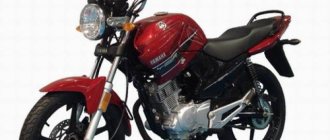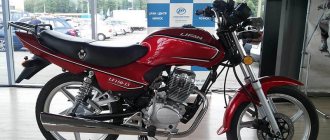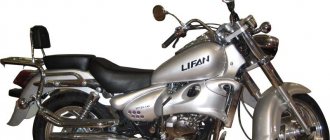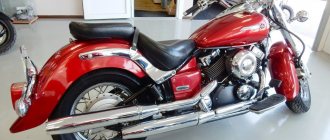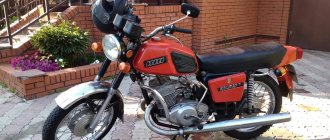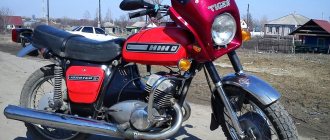"Pannonia", a motorcycle produced by the Hungarian engineering enterprise Csepel, was produced from 1954 to 1975. Hungarian engineers took the German-made DKW RT-125 motorcycle as the basis for the design. Several prototypes were called "Chepel". And when the project was developed and a new full-fledged model TL 250 was mastered, it received the name Pannonia. “Pannonia” is a motorcycle with good characteristics for that time, with a cylinder capacity of 250 cc/cm, stable on the move and easy to control. It appealed to the general public.
Motorcycle "Pannonia": technical characteristics
The motorcycle is characterized by the following indicators:
- engine - single-cylinder, two-stroke;
- cylinder volume - 246 cm3;
- piston stroke - 68 mm;
- compression ratio - 39.8;
- cylinder diameter - 68 mm;
- maximum power - 14 hp;
- maximum speed - 110 km/h;
- wheelbase - 1380 mm;
- motorcycle length - 2100 mm;
- height - 980 mm;
- distance from the steering wheel to the front saddle - 650 mm;
- width - 680 mm;
- ground clearance - 130 mm;
- weight - 146 mm;
- gas tank capacity - 18 liters;
- reserve capacity for refueling, with switch - 4 liters.
The Pannonia motorcycle, the characteristics of which were already at a fairly high level, was nevertheless constantly improved during the production process. There were no fundamental changes, but during the assembly line small changes were regularly made that helped improve the image of the car. Particular attention was paid to the level of comfort of the “Pannonia”, the saddles were separated, and the shock absorption was improved.
Notes[ | ]
- ↑ 1 2 3 4 A. E. Vorontsov, E. V. Pevzner, D. V. Dolnikov, A. G. Popov, R. M. Sazonov.
Encyclopedia of motorcycles. Firms. Models. Constructions. - M.: “Behind the Wheel”, 2003. - 576 p. — 6000 copies. — ISBN 5-85907-340-2. - L. Shugurov.
Motorcycle Pannonia // "Moto". - 1994. - No. 2. - Farewell "Pannonia" (undefined)
.
“Behind the Wheel”, No. 12, 1976
(December 1976). Date accessed: December 12, 2022. - RC-Forum - scale model collectors' forum - Show message separately - Pannonia, Csepel, Hungary - Poland
Electrical equipment
“Pannonia” is equipped with an inertial-type flywheel ignition, voltage 6 volts, power 45 watts. The dyna is mounted on the end of the main drive shaft and interacts with the voltage regulator and generator. The spark plug is standard, M14 from Bosch. The power supply circuit for on-board consumers is common, adopted for most middle-class motorcycles. Six-volt lighting bulbs do not quite meet the requirements for night use; they are low-power. Otherwise, the electrical equipment of the motorcycle is quite reliable and does not require adjustment.
Excerpt characterizing Pannonia (motorcycle)
- Oh, how lovely! Well, now sleep, and that's the end. “You sleep, but I can’t,” answered the first voice approaching the window. She apparently leaned out of the window completely, because the rustling of her dress and even her breathing could be heard. Everything became quiet and petrified, like the moon and its light and shadows. Prince Andrei was also afraid to move, so as not to betray his involuntary presence. - Sonya! Sonya! – the first voice was heard again. - Well, how can you sleep! Look what a beauty it is! Oh, how lovely! “Wake up, Sonya,” she said almost with tears in her voice. - After all, such a lovely night has never, never happened. Sonya reluctantly answered something. - No, look what a moon it is!... Oh, how lovely! Come here. Darling, my dear, come here. Well, do you see? So I would squat down, like this, I would grab myself under the knees - tighter, as tight as possible - you have to strain. Like this! - Come on, you'll fall. There was a struggle and Sonya’s dissatisfied voice: “It’s two o’clock.” - Oh, you're just ruining everything for me. Well, go, go. Again everything fell silent, but Prince Andrei knew that she was still sitting here, he sometimes heard quiet movements, sometimes sighs. - Oh my god! My God! what is this! – she suddenly screamed. - Sleep like that! – and slammed the window. “And they don’t care about my existence!” thought Prince Andrei as he listened to her conversation, for some reason expecting and fearing that she would say something about him. - “And there she is again! And how on purpose!” he thought. In his soul suddenly arose such an unexpected confusion of young thoughts and hopes, contradicting his whole life, that he, feeling unable to understand his condition, immediately fell asleep. The next day, having said goodbye to only one count, without waiting for the ladies to leave, Prince Andrei went home. It was already the beginning of June when Prince Andrei, returning home, again drove into that birch grove in which this old, gnarled oak had struck him so strangely and memorably. The bells rang even more muffled in the forest than a month and a half ago; everything was full, shady and dense; and the young spruces, scattered throughout the forest, did not disturb the overall beauty and, imitating the general character, were tenderly green with fluffy young shoots. It was hot all day, a thunderstorm was gathering somewhere, but only a small cloud splashed on the dust of the road and on the succulent leaves. The left side of the forest was dark, in shadow; the right one, wet and glossy, glistened in the sun, slightly swaying in the wind. Everything was in bloom; the nightingales chattered and rolled, now close, now far away. “Yes, here, in this forest, there was this oak tree with which we agreed,” thought Prince Andrei. “Where is he,” Prince Andrei thought again, looking at the left side of the road and without knowing it, without recognizing him, he admired the oak tree that he was looking for. The old oak tree, completely transformed, spread out like a tent of lush, dark greenery, swayed slightly, swaying slightly in the rays of the evening sun. No gnarled fingers, no sores, no old mistrust and grief - nothing was visible. Juicy, young leaves broke through the tough, hundred-year-old bark without knots, so it was impossible to believe that this old man had produced them. “Yes, this is that same oak tree,” thought Prince Andrei, and suddenly an unreasonable, spring feeling of joy and renewal came over him. All the best moments of his life suddenly came back to him at the same time. And Austerlitz with the high sky, and the dead, reproachful face of his wife, and Pierre on the ferry, and the girl excited by the beauty of the night, and this night, and the moon - and all this suddenly came to his mind. “No, life is not over at the age of 31, Prince Andrei suddenly finally, permanently decided. Not only do I know everything that is in me, it is necessary for everyone to know it: both Pierre and this girl who wanted to fly into the sky, it is necessary for everyone to know me, so that my life does not go on for me alone So that they don’t live so independently of my life, so that it affects everyone and so that they all live with me!” Returning from his trip, Prince Andrei decided to go to St. Petersburg in the fall and came up with various reasons for this decision. A whole series of reasonable, logical arguments why he needed to go to St. Petersburg and even serve were ready at his service every minute. Even now he did not understand how he could ever doubt the need to take an active part in life, just as a month ago he did not understand how the thought of leaving the village could have occurred to him. It seemed clear to him that all his experiences in life would have been in vain and would have been meaningless if he had not applied them to action and taken an active part in life again. He did not even understand how, on the basis of the same poor reasonable arguments, it had previously been obvious that he would have humiliated himself if now, after his life lessons, he again believed in the possibility of being useful and in the possibility of happiness and love. Now my mind suggested something completely different. After this trip, Prince Andrei began to get bored in the village, his previous activities did not interest him, and often, sitting alone in his office, he got up, went to the mirror and looked at his face for a long time. Then he turned away and looked at the portrait of the deceased Lisa, who, with her curls whipped up a la grecque [in Greek], tenderly and cheerfully looked at him from the golden frame. She no longer spoke the same terrible words to her husband; she simply and cheerfully looked at him with curiosity. And Prince Andrei, clasping his hands back, walked around the room for a long time, now frowning, now smiling, reconsidering those unreasonable, inexpressible in words, secret as a crime thoughts associated with Pierre, with fame, with the girl on the window, with the oak tree, with female beauty and love that changed his whole life. And at these moments, when someone came to him, he was especially dry, strictly decisive and especially unpleasantly logical.
Production development
In 1956, the new TLT 250 model was introduced, and two years later, the TLF modification was introduced in two versions: TLB, which featured separate saddles, and TLD, with a new efficient 60-watt generator ignition system. Mass production of the TLT series marked the beginning of the export of the Pannonia to the Soviet Union, which soon became the main buyer of Hungarian motorcycle products throughout Europe. The USSR Foreign Trade received 25,000 cars per year. However, Hungary sent “Pannonia” to other European countries, as well as to the USA. No more than 30 percent of all motorcycles produced remained for domestic consumers.
The Pannonia, a motorcycle of perfect design, reliable and relatively inexpensive to operate, became increasingly popular. However, progress required further development, and in 1968 the Cepel enterprise launched a new model P20, replacing the outdated TLT modifications. The P20 was copied from the Japanese Yamaha YDS-2. The car turned out to be high-class, with excellent driving characteristics, but the quality was too expensive, its retail price increased several times. The management of “Chepel” soon realized their miscalculations; they should not have destroyed the already created sales structures for the sake of ephemeral ambitions to create new supermotorcycles under the “Pannonia” brand, even if based on analogies with Japanese motorcycles. The market has its own strict laws and they ultimately led the production of a successful model with good prospects to stagnation and then to closure.
Gallery
- Csepel 250 oldalkocsival.JPG
Csepel 250/51 EF
- Pannonia.jpg
Pannonia TLT 250
- Pannonia Csepel 250 T1 Side 1959a.JPG
Pannonia 250 T1
- Pannonia TLB De Luxe 250.jpg
Pannonia TLB De Luxe 250
- Pannonia Csepel 250 T5 1960.JPG
Pannonia 250 T5
- Pannonia P 12.JPG
Pannonia P12
Fall in demand
The Soviet Union was the first to abandon the P20 model, considering it too expensive to purchase equipment that was too complex and expensive. Then several more countries announced their refusal. The Hungarian manufacturer began to have problems with the sale of products, which quickly turned into insurmountable difficulties. In 1975, production of Pannonia was discontinued. Warehouse stocks were gradually sold, but there were no new arrivals.
The Pannonia project, a motorcycle with a high reputation, quite advanced for its time, ceased to exist. However, you can still see on the roads throughout the entire former USSR a two-wheeled black car with a characteristic profile, as a memory of the past.
Pannonia T5
After a short break, the Soviet Union entered into large contracts with the Hungarian plant Csepel and the Czech Jawa.
From that moment on, supplies increased tenfold. For example, about 50% of Pannonia motorcycles were sold in the USSR, and more than 90 of Yavs. The Pannonia T5 model became really popular. Along with the Jawa “Chekushka”, the motorcycle was in high demand among the population, usually in cities. In the villages they were afraid to deal with “foreign cars” - it was much more difficult to find spare parts there.
Motorcyclists respected the Pannonia T5 for:
